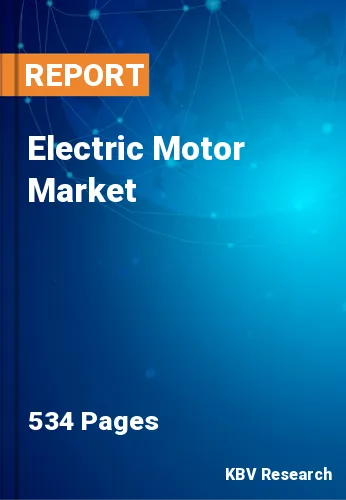The Global Electric Motor Market size is expected to reach $236.3 billion by 2030, rising at a market growth of 7.4% CAGR during the forecast period. In the year 2022, the market attained a volume of 2,56,315.9 thousand units, experiencing a growth of 7.6% (2019-2022).
In fully electric vehicles (battery-electric vehicles or BEVs), electric motors provide the primary source of propulsion. Therefore, the Motor Vehicles segment acquired $46,102.4 million revenue in 2022. They convert electrical energy from the vehicle's battery into mechanical energy to drive the wheels. This eliminates the necessity for a traditional internal combustion engine, resulting in zero tailpipe emissions. They are used in EPS systems to assist with steering, providing variable levels of assistance based on driving conditions. This technology enhances driver comfort and control while reducing fuel consumption compared to hydraulic power steering. The growing popularity of electric vehicles and the continued development of hybrid and electric technologies drive the widespread use of these motors in motor vehicles. These motors are essential for achieving cleaner, more energy-efficient transportation options reducing greenhouse gas emissions and dependency on fossil fuels.
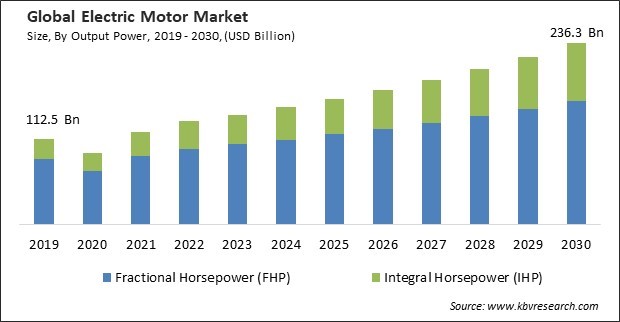
The major strategies followed by the market participants are Partnerships as the key developmental strategy to keep pace with the changing demands of end users. For instance, In September, 2023, ABB Group came into partnership with SMS Group. Through this partnership, ABB Group would provide an electric powertrain system and medium voltage motors in Hazira, Gujarat. Additionally, In April, 2023, Mitsubishi Electric Corporation came into partnership with SolidCAM, with this partnership, Mitsubishi Electric Corporation would enhance the CNC control system for providing machining needs to its customers.
Based on the Analysis presented in the KBV Cardinal matrix; Hitachi, Ltd., Siemens AG and Emerson Electric Co. are the forerunners in the Market. Companies such as ABB Group, Robert Bosch GmbH, Denso Corporation are some of the key innovators in the Electric Motor Market. In November, 2022, ABB Group came into partnership with RMS (Rotating Machinery Supplies Ltd), a leading importer and wholesaler of electric motors, industrial gearboxes, VSD, and ventilation equipment. Through this partnership, ABB Group provide solution and services in New Zealand to support RMS.
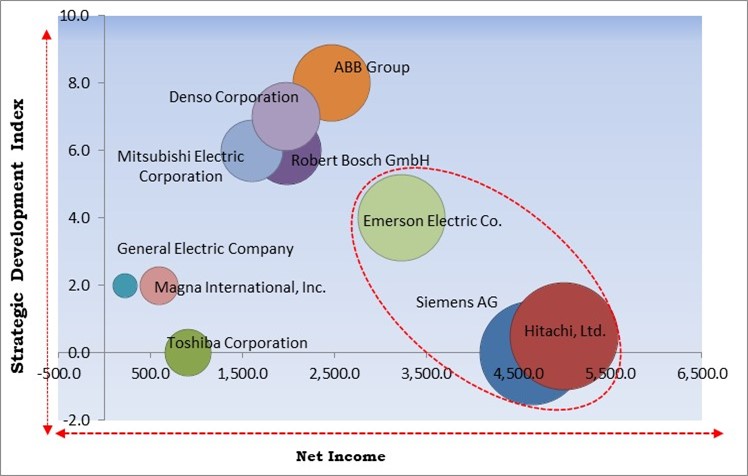
Energy-efficient electric motors are designed to convert more electrical power into mechanical power, resulting in lower energy consumption. Businesses and industries can significantly reduce their operating costs by using these motors, which is a strong incentive for their adoption. Many countries have implemented regulations and standards that require the use of energy-efficient motors. Businesses are compelled to comply with these standards, which encourages the adoption of such motors. The increased demand for energy-efficient motors will likely continue to drive innovation in the motor industry and promote their adoption across various sectors. As energy efficiency remains a critical consideration in business and policy decisions, the market will expand.
Technology innovations have led to the development of higher-efficiency electric motors. These motors convert more electrical energy into mechanical power, reducing energy consumption and operational cost savings. VFDs use advanced electronics to control the speed and torque of these motors. This data is crucial for motor control and diagnostics, enabling smarter and more efficient motor operation. These technology advancements have expanded the market by addressing energy efficiency, performance, and control challenges, making these motors an integral part of various industries and applications, from industrial machinery to electric vehicles to smart buildings. The ongoing pursuit of innovation and sustainability is expected to drive the growth of the market.
The initial purchase price of high-efficiency electric motors, such as premium-efficiency or energy-efficient models, can be notably higher than standard motors. This upfront cost can deter some buyers from choosing the most efficient options. For example, pneumatic or hydraulic systems may be considered alternatives to electric motors in certain industrial processes. In the consumer appliance sector, where price is a significant factor for consumers, manufacturers may choose standard motors to keep product costs low. This can limit the availability of more energy-efficient appliances. A misalignment between supply and demand occurs, resulting in manufacturers of components or parts incurring financial losses. Purchasing critical components utilized in producing electric motors in US dollars typically results in increased component costs. The above factors will hamper the market growth.
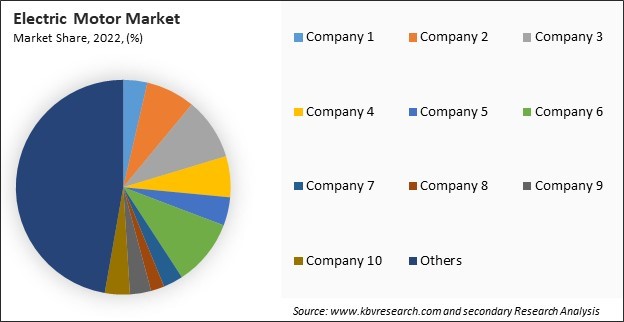
The leading players in the market are competing with diverse innovative offerings to remain competitive in the market. The above illustration shows the percentage of revenue shared by some of the leading companies in the market. The leading players of the market are adopting various strategies in order to cater demand coming from the different industries. The key developmental strategies in the market are Partnerships, Collaborations & Agreements.
Based on output power, the market is fragmented into fractional horsepower (FHP) and integral horsepower (FHP). In 2022, the fractional horsepower (FHP) output segment generated the largest revenue share in the market. Many household appliances, like blenders, food processors, and vacuum cleaners, use fractional horsepower electric motors. These motors are designed to provide sufficient power for the specific task without consuming excessive energy. Some small machinery and tools, including bench grinders, small lathes, and band saws, use FHP motors. These motors are suitable for hobbyists and small-scale applications. Fractional horsepower pumps are used in applications like circulating hot water in hydronic heating systems or moving water in small aquariums. The use of FHP motors is common in situations where the power requirements are relatively low and where efficiency and cost-effectiveness are priorities. These motors are available in various power ratings, like 1/4 hp, 1/3 hp, and 1/2 hp, allowing designers and engineers to select the appropriate motor size for the specific application.
On the basis of type, the market is segmented into AC motor, DC motor, hermetic motor. The DC motor segment garnered a significant revenue share in the market in 2022. DC motors are commonly used as starter motors in internal combustion engine vehicles, providing the initial rotational force needed to start the engine. Many machine tools, such as lathes and milling machines, use DC motors to control rotational speeds and cutting operations. DC motors are often used in robotic arms and actuators, providing precise and controlled movements. DC motors are used in vacuum cleaners, kitchen appliances, and power tools for various functions. DC motors are used in multiple laboratory devices, such as centrifuges and shakers, where precise control over rotation is required.
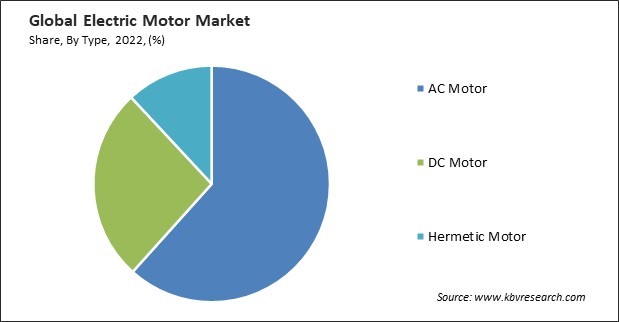
Under AC motor type, the market is further divided into synchronous and induction. In 2022, the induction segment held the highest revenue share in the market. Induction motors operate based on Faraday's law of electromagnetic induction. They induce a rotating magnetic field in the stator (the stationary part) when AC voltage is applied, which induces currents in the rotor (the rotating part) by electromagnetic induction. The interaction between the rotating magnetic field and the rotor currents generates mechanical rotation. Induction AC motors are versatile and widely used due to their self-starting capability, durability, and efficiency. They serve a broad spectrum of applications, from household appliances to heavy industrial machinery, and continue to be a workhorse in various industries. Using variable frequency drives has expanded their versatility, allowing for speed control and energy savings in many applications.
Under DC motor type, the market is categorized into brushless and brushed. In 2022, the brushless segment registered the highest revenue share in the market. BLDC motors use electronic circuits and sensors to control the timing of the current in the motor's windings. This precise control allows for accurate speed and position regulation. BLDC motors are known for their high efficiency. They generate less heat due to reduced friction and are more energy-efficient than brushed DC motors. This efficiency is essential in battery-powered applications. They are used in medical instruments and devices, such as infusion pumps and surgical tools. They are found in computer hard drives, DVD and Blu-ray drives, and cooling fans for electronic devices. BLDC motors can be used for regenerative braking, acting as generators to recover and store energy during deceleration, improving overall efficiency.
By end user, the market is classified into motor vehicles, industrial machinery, HVAC equipment, household appliances, aerospace & transportation, and others. The heating, ventilating, and cooling (HVAC) equipment segment projected a prominent revenue share in the market in 2022. These fans ensure the proper distribution of conditioned air throughout the building. They drive the compressor and condenser fans in air conditioning units. These fans are crucial for heat exchange, allowing the refrigeration cycle to remove heat from indoor spaces. These motors in HVAC equipment are designed for energy efficiency, reliability, and precise control, essential for maintaining a comfortable and healthy indoor environment. Their use contributes to improved energy efficiency, reduced energy consumption, and lower operational costs in heating, cooling, and ventilation techniques in both residential and commercial settings.
| Report Attribute | Details |
|---|---|
| Market size value in 2022 | USD 134.7 Billion |
| Market size forecast in 2030 | USD 236.3 Billion |
| Base Year | 2022 |
| Historical Period | 2019 to 2021 |
| Forecast Period | 2023 to 2030 |
| Revenue Growth Rate | CAGR of 7.4% from 2023 to 2030 |
| Number of Pages | 534 |
| Number of Table | 1053 |
| Quantitative Data | Volume in Thousand Units, Revenue in USD Billion, and CAGR from 2019 to 2030 |
| Report coverage | Market Trends, Revenue Estimation and Forecast, Segmentation Analysis, Regional and Country Breakdown, Competitive Landscape, Porter’s 5 Forces Analysis, Market Share Analysis, Company Profiling, Companies Strategic Developments, SWOT Analysis, Winning Imperatives |
| Segments covered | Type, Output Power, End User, Region |
| Country scope |
|
| Companies Included | Robert Bosch GmbH, General Electric Company, Siemens AG, Hitachi, Ltd., Mitsubishi Electric Corporation, ABB Group, Denso Corporation, Magna International, Inc., Toshiba Corporation, Emerson Electric Co. |
| Growth Drivers |
|
| Restraints |
|
Region-wise, the market is analyzed across North America, Europe, Asia Pacific, and LAMEA. In 2022, the Asia Pacific region dominated the market with the maximum revenue share. Asia-Pacific is a highly developing region with the fastest-growing population. According to the United Nations, nearly two-thirds of the world population resides in Asia-Pacific, with China and India alone accounting for one-third of the global population. In addition, the rate of urbanization in Asia-Pacific is also high. Thus, owing to high population growth and urbanization in the region, the industrial, automotive, and household sectors have witnessed a rapid rise. Therefore, demand for electric motors, extensively used in these sectors, is anticipated to rise in the coming years.
Free Valuable Insights: Global Electric Motor Market size to reach USD 236.3 Billion by 2030
The market research report covers the analysis of key stake holders of the market. Key companies profiled in the report include Robert Bosch GmbH, General Electric Company, Siemens AG, Hitachi, Ltd., Mitsubishi Electric Corporation, ABB Group, Denso Corporation, Magna International, Inc., Toshiba Corporation, Emerson Electric Co.
By Output Power (Volume, Thousand Units, USD Billion, 2019-2030)
By Type (Volume, Thousand Units, USD Billion, 2019-2030)
By End User (Volume, Thousand Units, USD Billion, 2019-2030)
By Geography (Volume, Thousand Units, USD Billion, 2019-2030)
This Market size is expected to reach $236.3 billion by 2030.
Increase in demand for energy-efficient electric motors are driving the Market in coming years, however, High initial cost of electric motors restraints the growth of the Market.
Robert Bosch GmbH, General Electric Company, Siemens AG, Hitachi, Ltd., Mitsubishi Electric Corporation, ABB Group, Denso Corporation, Magna International, Inc., Toshiba Corporation, Emerson Electric Co.
In the year 2022, the market attained a volume of 2,56,315.9 thousand units, experiencing a growth of 7.6% (2019-2022).
The AC Motor segment is leading the Market by Type in 2022; there by, achieving a market value of $141.0 billion by 2030.
The Asia Pacific region dominated the Market by Region in 2022 and would continue to be a dominant market till 2030; thereby, achieving a market value of $110.0 billion by 2030.
Our team of dedicated experts can provide you with attractive expansion opportunities for your business.
